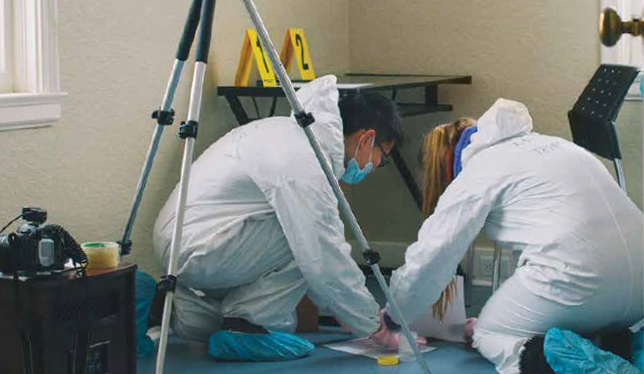
Valeria Silkina has arrived at a quaint two-storey farmhouse in the north end of Oshawa, Ontario, ready to work. The house is as mundane as they come: dove grey stucco and white clapboard siding, white shutters, and white trim. Surrounded by acres of tranquil farmland, you’d never guess there was a dead body in the master bedroom.
Decked out in a white “bunny suit” (hooded coveralls) and armed with a tablet computer, digital cameras and evidence kits, Ms. Silkina and her team document the grizzly scene inside and collect palm impressions, soil samples, a drinking glass from the ensuite bathroom and a noose hanging from a closet. Ms. Silkina thinks the latter may be a red herring: the noose is actually too small to fit over the victim’s head. Plus, how do you explain the blood on the victim’s nose and chest though she was found on her back in bed? It’s a real head-scratcher, but one they’re sure to figure out within the next few weeks; their final grades in the third-year criminalistics class depend on it.
That’s because the house is in fact a teaching facility, dubbed the Crime Scene House, for the forensic science program at the University of Ontario Institute of Technology, where Ms. Silkina is a student. “It’s a little creepy,” Ms. Silkina says of the simulations, but she admits they have helped her to overcome her squeamishness around blood and have completely debunked her assumptions about crime-scene science gleaned from police procedurals. “There’s a lot more analysis that goes into it than they show on TV. … It’s not as simple as pressing a button and having everything done for you. There’s a human aspect to it.”
Lab coordinator Kimberly Nugent organizes the scenarios and develops the practical curriculum for the facility, with input from faculty. “We’re trying to give them the fundamentals and the science” of how to recognize, collect and analyze evidence, she says.
The school officially relaunched the lab last fall at the old Windfields Farm site, a former horse-breeding farm north of the main campus that the university purchased in the early 2000s. Previously, the crime scenarios had played out in an obsolete forest ranger cabin at a Boy Scouts camp.
The main floor of the facility holds a proper classroom and office complete with closed-circuit cameras to observe students working in the labs. The basement provides a prep area and storage for kits, protective gear and tablets (the lab is paper-free). The second storey is made up of three sparsely furnished bedrooms which have already seen more than their fair share of suspicious deaths, break-and-enters and blood splatter. Outside, a couple of beat-up cars offer lessons on hit-and-run investigations, and in the back yard upper-year students learn how to investigate a shooting, excavate a clandestine grave and analyze decomposition, with fetal pigs standing in for human corpses.
For Ms. Nugent, managing the off-site lab is like owning a second home – in addition to the usual lab-maintenance concerns, it’s her responsibility to tend to burst pipes, malfunctioning furnaces and the like. But the extra trouble is worth it for the educational experience it offers the students. “The opportunity to get in there and do what they see on TV, they really enjoy it,” she says. “By far, when they come out of the program, they say their best experience is the labs they’ve done at the Crime Scene House.”
How does one go about donating their body to this wonderful program?